Weeds with purple flowers can be found in many gardens and wild spaces, adding a splash of color to often overlooked areas. While some may see them as nuisances, these hardy plants can provide beauty and attract beneficial insects. Identifying these purple-flowered weeds can help you appreciate their role in nature, whether you’re gardening or simply enjoying the outdoors.
Creeping Charlie Identification
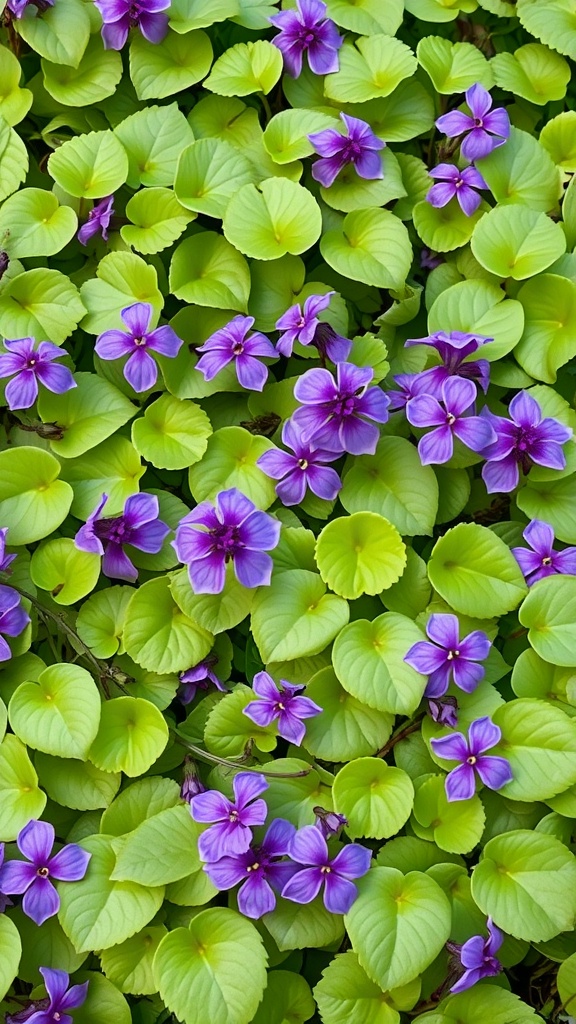
Creeping Charlie, also known as ground ivy, is a common weed that can be easily identified by its vibrant purple flowers. These flowers bloom in clusters and stand out against the bright green, round leaves. The contrast of colors makes it a striking sight in gardens and lawns.
The leaves of Creeping Charlie are unique, with a slightly hairy texture and a distinctive shape. They grow close to the ground, spreading out and forming a dense mat. This growth habit can make it a challenge for other plants to thrive in the same area.
When identifying Creeping Charlie, look for the purple flowers that typically appear in spring. They have a tubular shape and can attract various pollinators. If you spot these flowers along with the characteristic leaves, you likely have Creeping Charlie in your garden.
Henbit Flowering Habits
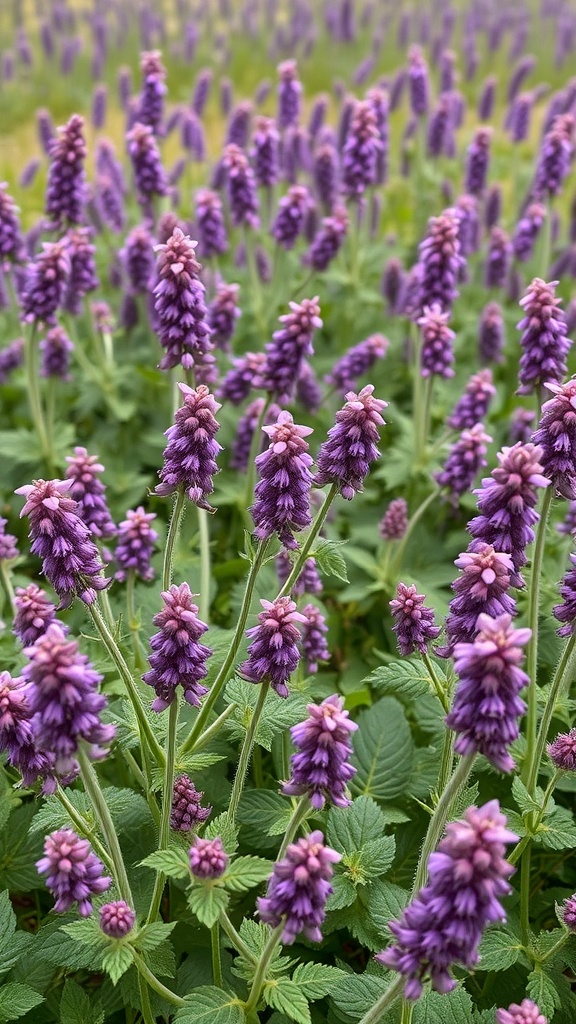
Henbit is a charming weed that often catches the eye with its lovely purple flowers. These blooms typically appear in early spring and can last through late spring. The flowers grow in clusters, creating a vibrant display that brightens up any landscape.
The flowering habits of henbit are quite fascinating. Each flower has a tubular shape, which attracts various pollinators like bees and butterflies. This makes henbit not just a pretty sight, but also a helpful plant for the ecosystem.
Henbit thrives in disturbed soils, often popping up in gardens, fields, and along roadsides. Its ability to spread quickly means it can cover large areas, creating a stunning purple carpet. While some may see it as a nuisance, many appreciate its beauty and the role it plays in supporting local wildlife.
Wild Bergamot Flowering
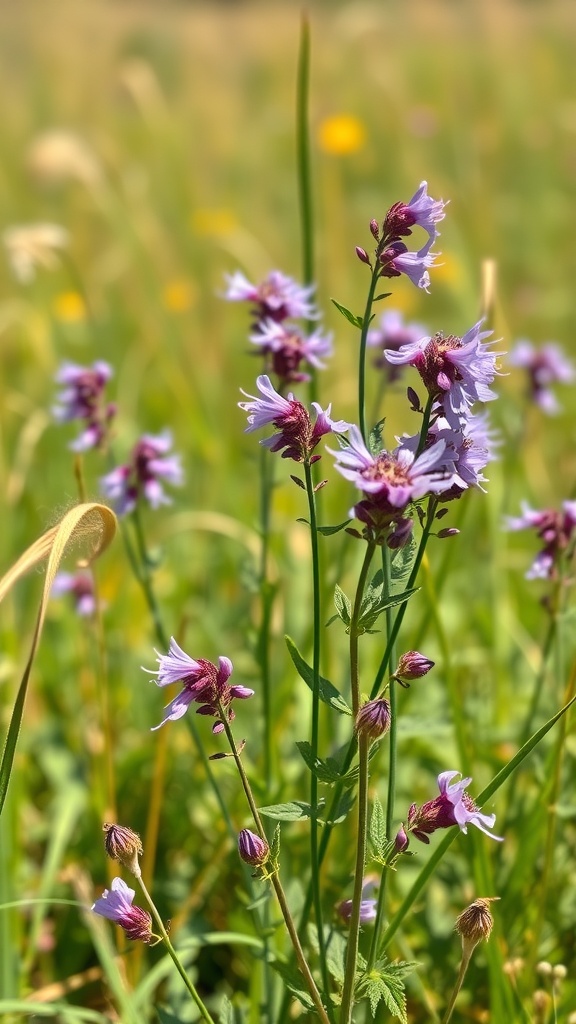
Wild Bergamot, known for its charming purple flowers, adds a splash of color to any meadow. These flowers bloom in clusters, showcasing delicate petals that attract a variety of pollinators. The vibrant purple hue stands out beautifully against the green backdrop of grass and other plants.
As the flowers open, they release a light, pleasant fragrance. This scent not only draws in bees and butterflies but also brings a sense of calm to anyone passing by. The tall stems of Wild Bergamot can reach up to four feet, making them a noticeable feature in wildflower gardens.
These flowers thrive in sunny spots and can often be found in fields and along roadsides. Their resilience makes them a favorite among gardeners looking to support local wildlife. Whether you’re a nature lover or just enjoy a stroll through the wild, the sight of Wild Bergamot in full bloom is sure to brighten your day.
Purple Vetch Growth Patterns
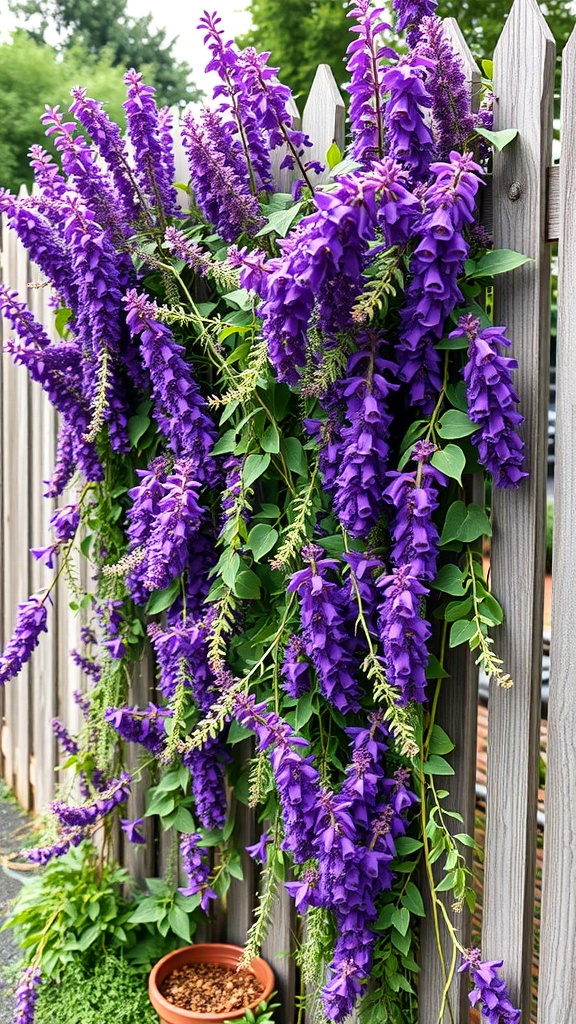
Purple vetch is a stunning plant that can add a splash of color to any garden. Its vibrant purple flowers create a beautiful contrast against green foliage. This plant often grows in clusters, making it a striking sight when in full bloom.
The growth pattern of purple vetch is quite unique. It tends to climb and spread, often using nearby structures for support. In the image, you can see how it gracefully drapes over a wooden fence, showcasing its long, cascading flowers. This climbing habit not only enhances its visual appeal but also allows it to thrive in various environments.
As it grows, purple vetch can attract pollinators like bees and butterflies, making it a great addition to any garden focused on supporting local wildlife. Its growth is vigorous, so regular maintenance may be needed to keep it in check and looking its best.
Common Bluebell Habitat
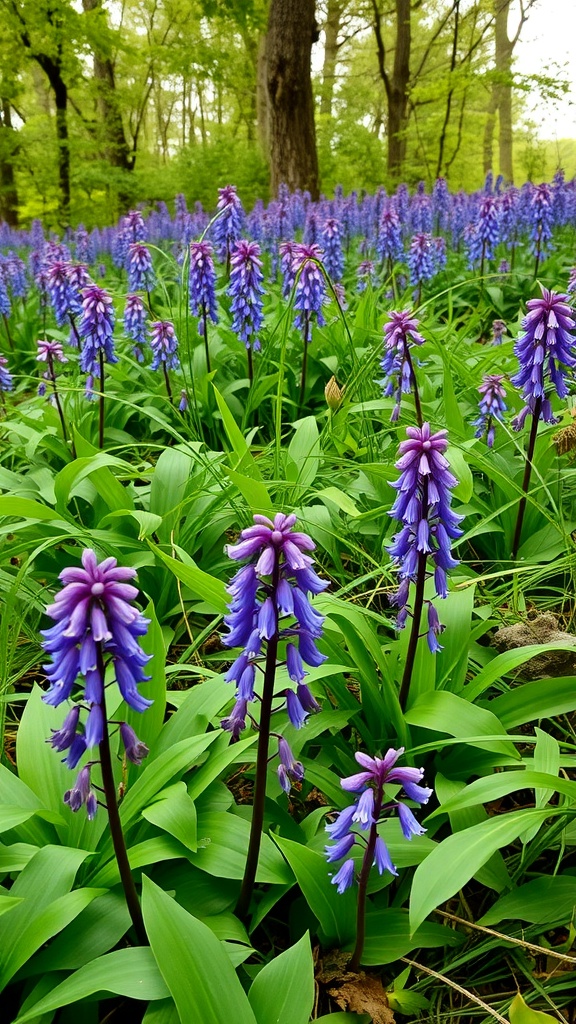
The common bluebell, with its striking purple flowers, thrives in specific habitats that make it a delight to see in spring. These flowers often blanket woodlands, creating a stunning visual display. The vibrant hues stand out against the fresh green foliage, making a walk through these areas feel magical.
Bluebells prefer damp, shaded spots, often found in ancient woodlands. They flourish in rich, well-drained soil, which helps them grow tall and strong. The combination of sunlight filtering through the trees and the moisture in the ground creates the perfect environment for these lovely blooms.
In addition to woodlands, bluebells can also be found in grassy meadows and along woodland edges. They often grow in clusters, forming a sea of purple that attracts many visitors. This habitat not only supports the bluebells but also provides a home for various wildlife, making it a vibrant ecosystem.
Purple Deadnettle Characteristics
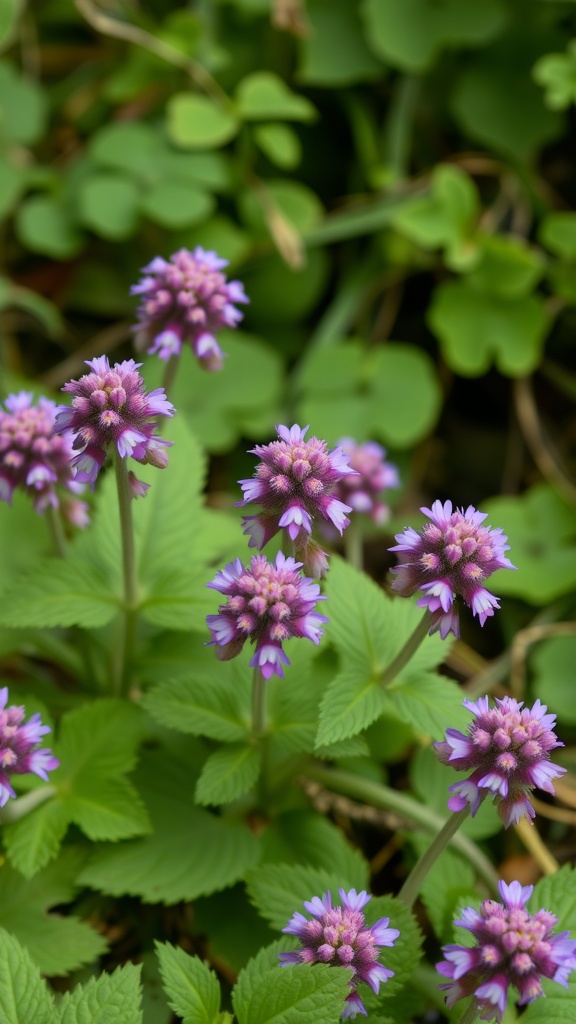
Purple deadnettle is a fascinating plant that often catches the eye with its vibrant purple flowers. These flowers bloom in clusters, creating a striking display against the backdrop of green leaves. The leaves are heart-shaped and have a slightly serrated edge, adding to the plant’s charm.
This plant typically grows low to the ground, reaching heights of about 12 to 24 inches. It thrives in various environments, often found in gardens, fields, and even along roadsides. The purple flowers usually appear in early spring, making it one of the first signs of color after winter.
One interesting feature of purple deadnettle is its ability to attract pollinators like bees and butterflies. This makes it a great addition to any garden, as it supports local wildlife. The flowers are not just pretty; they play a role in the ecosystem.
While some may consider it a weed, purple deadnettle has its own unique beauty and benefits. Its vibrant colors and ability to thrive in different conditions make it a noteworthy plant in any landscape.
Purple Loosestrife Invasiveness
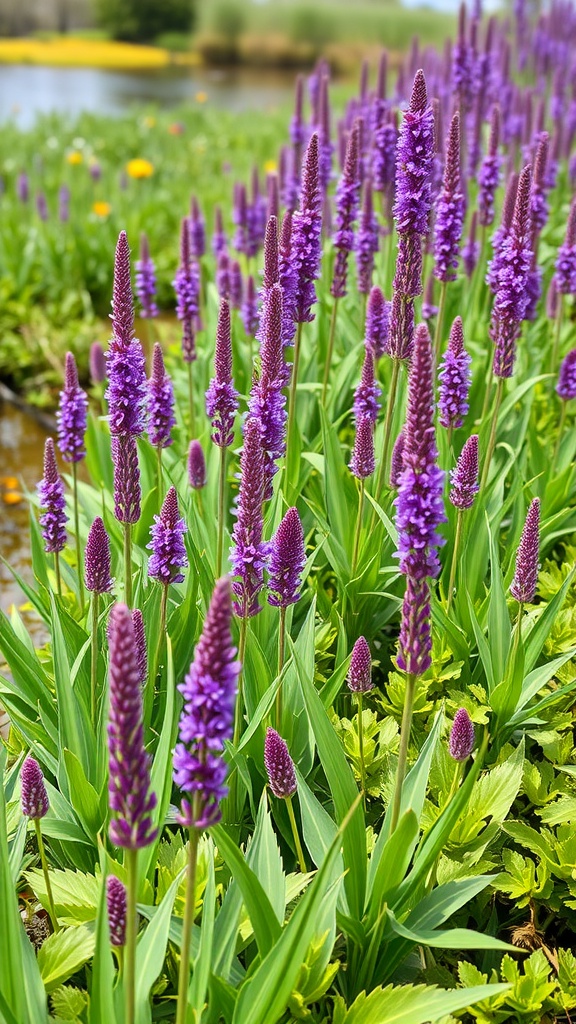
Purple loosestrife is a stunning plant with tall spikes of vibrant purple flowers. While it may catch your eye in gardens and wetlands, it’s important to know that this beauty can be quite invasive. Native to Europe and Asia, it has spread across North America, often outcompeting local flora.
The image shows a lush patch of purple loosestrife, standing tall by a water body. Its striking color can make it seem appealing, but this plant can disrupt ecosystems. It thrives in wetland areas, where it can choke out native plants, leading to a loss of biodiversity.
Managing purple loosestrife is crucial for maintaining healthy ecosystems. Many regions have implemented control measures to prevent its spread. If you spot it in your area, it’s best to report it to local environmental groups. Together, we can help protect our natural habitats from this invasive species.
Thistle Species with Purple Blooms
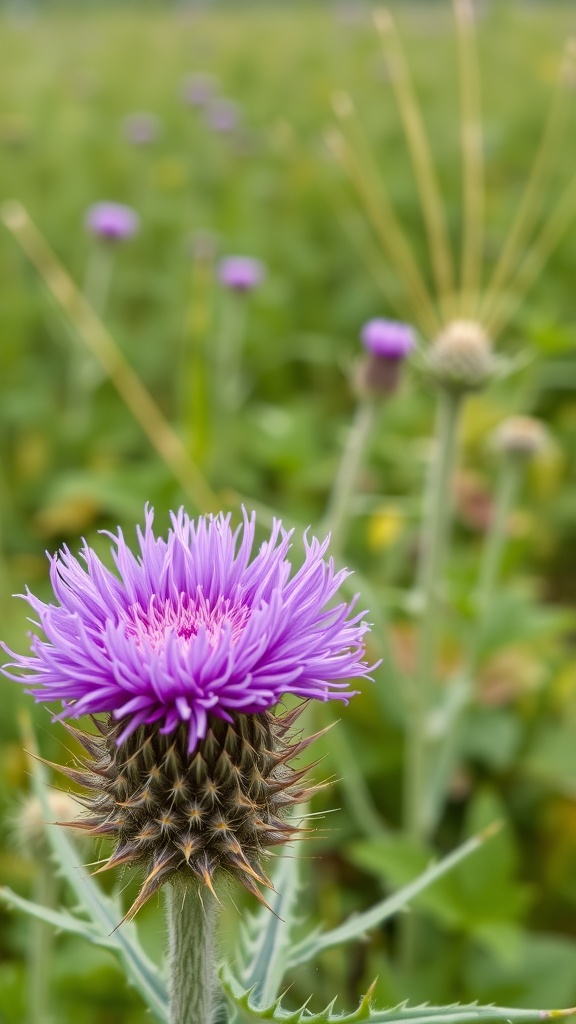
Thistles are fascinating plants, often overlooked in gardens and fields. Their striking purple flowers catch the eye and add a splash of color to any landscape. These blooms are not just pretty; they play a role in the ecosystem by attracting pollinators like bees and butterflies.
The image shows a vibrant thistle flower, showcasing its unique structure. The petals are spiky and feathery, creating a beautiful contrast against the green backdrop. This thistle stands tall, with its prickly leaves adding to its character. It’s a reminder that beauty can be found in unexpected places.
Thistles thrive in various environments, from meadows to roadsides. They are hardy plants that can grow in poor soil, making them resilient. While some may consider them weeds, their ecological benefits cannot be ignored. They provide food and habitat for many creatures, making them a valuable part of the natural world.
Next time you see a thistle, take a moment to appreciate its beauty and the role it plays in nature. These purple blooms are more than just weeds; they are a vital part of our ecosystem.
Purple Foxglove Habitat
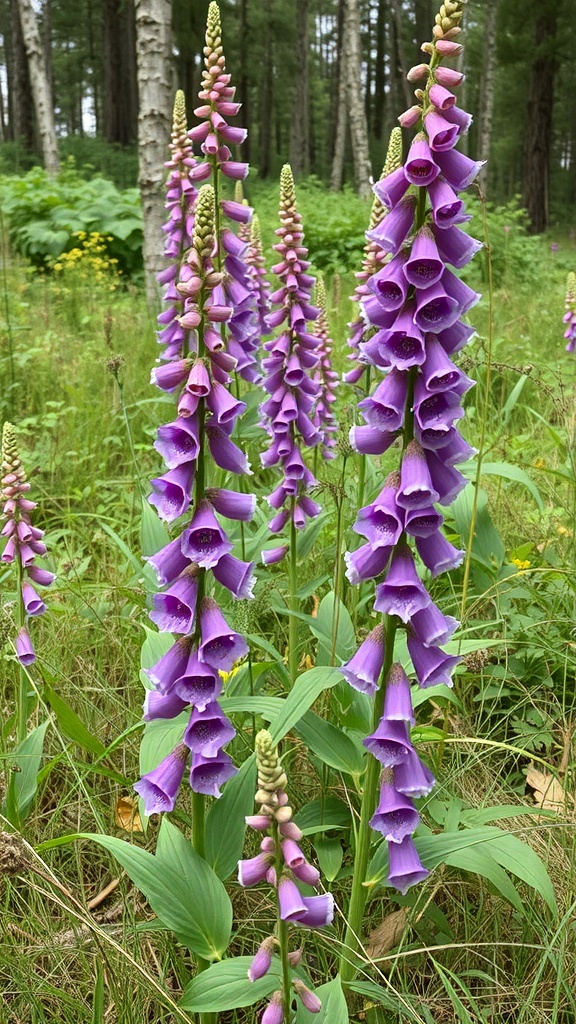
Purple foxglove, known for its tall spikes of vibrant purple flowers, thrives in various habitats. These beautiful plants often grow in woodlands, meadows, and even along roadsides. They prefer well-drained soil and can often be found in areas that receive partial shade.
The image shows a cluster of purple foxglove flowers standing tall among the greenery. Their bell-shaped blooms attract bees and other pollinators, making them a vital part of the ecosystem. The lush background hints at their natural habitat, where they flourish in a mix of sunlight and shade.
Foxgloves are biennial or perennial, meaning they can live for more than two years. In their first year, they focus on growing leaves and roots, while the second year brings those stunning flowers. This cycle makes them a delightful sight in gardens and wild areas alike.
Purple Flowering Amaranth Uses

Purple flowering amaranth is not just a pretty sight; it has many practical uses. These vibrant purple flowers can brighten up any garden or landscape. They add a splash of color and can attract pollinators like bees and butterflies.
In the kitchen, the leaves and seeds of amaranth are edible. The leaves can be used in salads or cooked like spinach. The seeds are nutritious and can be ground into flour or used in cereals. This makes amaranth a great addition to a healthy diet.
Beyond culinary uses, purple flowering amaranth is also valued in traditional medicine. Some cultures use it to treat various ailments. Its anti-inflammatory properties are particularly noted. This makes it a useful plant for those interested in natural remedies.
Lastly, these flowers can be used in crafts. Dried amaranth flowers can be incorporated into arrangements or used for decoration. Their unique shape and color make them a favorite among crafters.
Common Purple Flowering Weeds
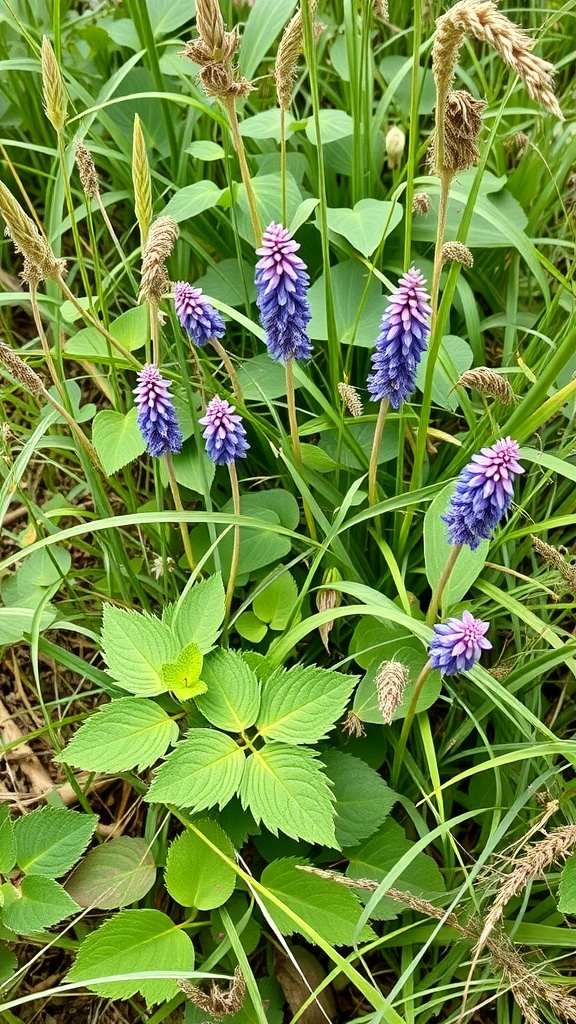
Purple flowering weeds can add a splash of color to any garden or lawn. One common type features vibrant purple flowers that stand tall among green foliage. These flowers often bloom in clusters, creating a striking visual effect.
In the image, you can see a group of these purple flowers, which are likely a type of wildflower. They have a unique shape, resembling small cones or spikes, with shades of purple and pink that catch the eye. The surrounding greenery adds to their beauty, making them a lovely addition to any natural setting.
These weeds are often found in meadows, fields, and even along roadsides. They thrive in various conditions and can be quite resilient. While some may consider them nuisances, their beauty is undeniable. Plus, they can attract pollinators like bees and butterflies, which are essential for a healthy ecosystem.
Identifying these weeds can be fun, especially if you enjoy gardening or nature walks. Keep an eye out for them next time you’re outdoors!
Purple Flowering Mint Characteristics
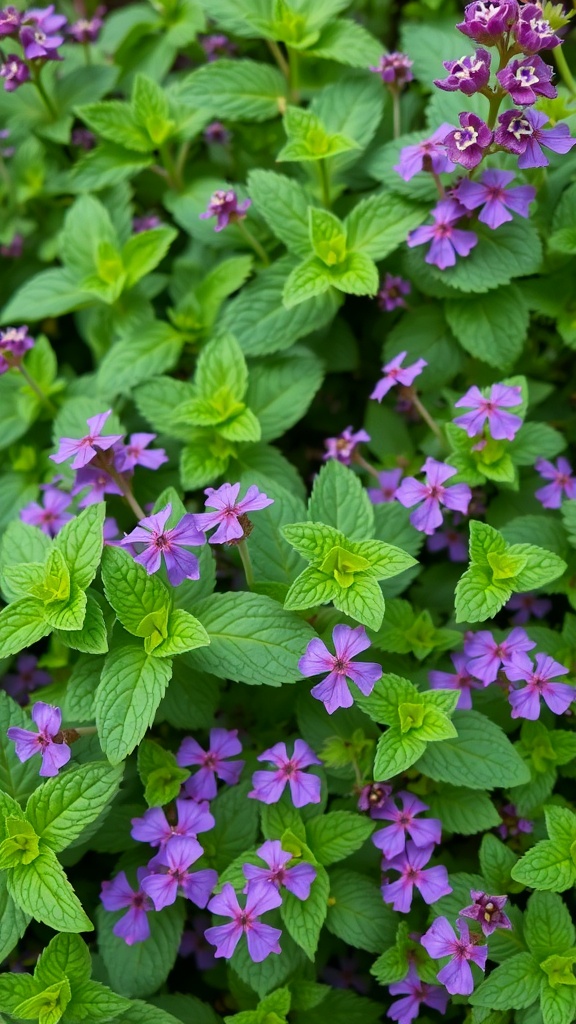
Purple flowering mint is a delightful sight in gardens and wild areas. Its vibrant purple flowers stand out beautifully against the lush green leaves. This plant is not just pretty; it has some interesting traits that make it unique.
The flowers bloom in clusters, creating a stunning display. Each bloom has a delicate shape, often attracting bees and butterflies. This makes it a great choice for gardeners looking to support local pollinators.
The leaves of purple flowering mint are also noteworthy. They are bright green, with a slightly serrated edge. When you crush them, they release a refreshing minty aroma. This scent can be invigorating and is often associated with culinary uses.
Growing purple flowering mint is relatively easy. It thrives in various soil types and can tolerate both sun and partial shade. This adaptability makes it a popular choice for many gardeners.
Overall, purple flowering mint is a charming addition to any garden. Its vibrant flowers and aromatic leaves bring joy and beauty to outdoor spaces.
Self-Heal Flower Benefits
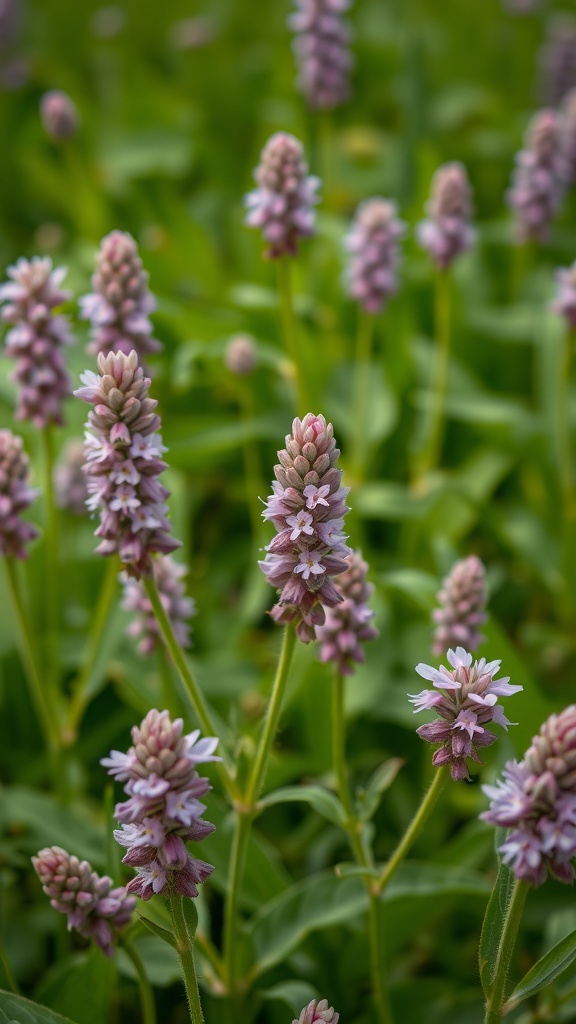
Self-heal, known for its charming purple flowers, is more than just a pretty sight. This plant thrives in various environments, often popping up in gardens and meadows. Its delicate blooms can be a delightful addition to any landscape.
One of the standout benefits of self-heal is its medicinal properties. Traditionally, it has been used to support wound healing and reduce inflammation. The leaves can be made into teas or poultices, offering a natural remedy for minor cuts and scrapes.
Moreover, self-heal is known to boost the immune system. Regular consumption of its extracts may help the body fend off common illnesses. This makes it a valuable ally for those looking to enhance their overall wellness.
In addition to its health benefits, self-heal attracts pollinators like bees and butterflies. This makes it a great choice for gardeners wanting to support local wildlife. By planting self-heal, you not only beautify your space but also contribute to a healthier ecosystem.
Bellflower Unique Features
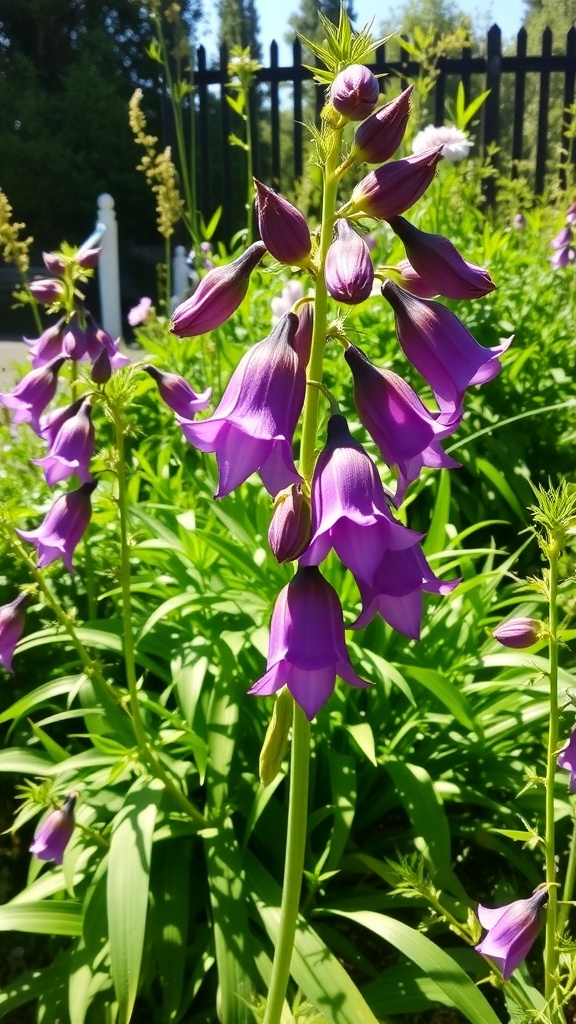
Bellflowers are known for their stunning purple blooms that add a pop of color to any garden. These flowers have a unique bell shape, which is where they get their name. The petals often have a lovely gradient, transitioning from a deep purple to a lighter shade, creating an eye-catching effect.
These plants typically grow tall, standing proudly among other garden favorites. Their slender stems and lush green foliage provide a beautiful backdrop for the vibrant flowers. Bellflowers are not just pretty; they are also hardy and can thrive in various conditions, making them a favorite among gardeners.
Another interesting feature is their ability to attract pollinators. Bees and butterflies are drawn to the sweet nectar, making bellflowers a great choice for those looking to support local wildlife. Overall, these unique features make bellflowers a delightful addition to any garden.
Violet Flowering Groundcovers
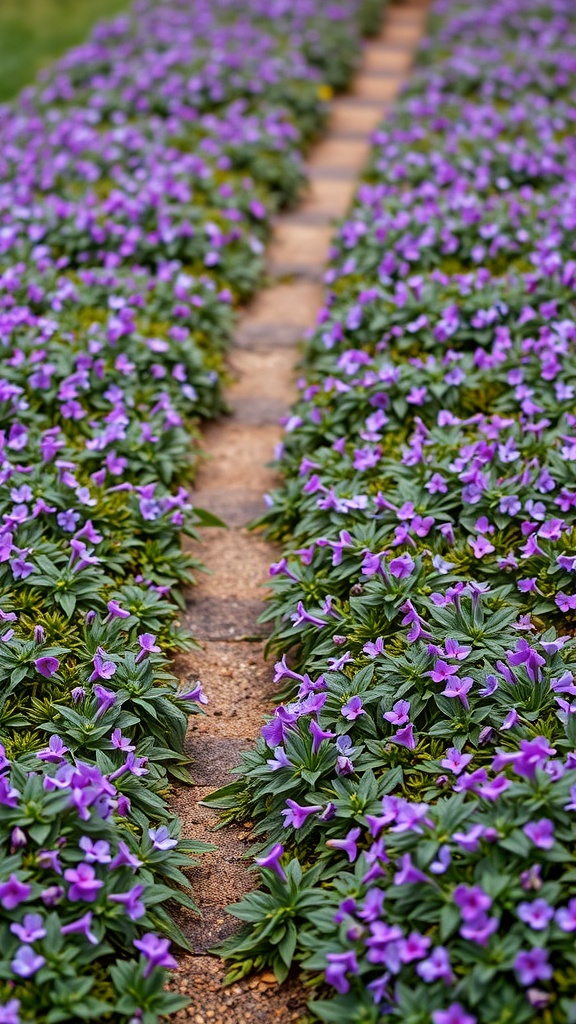
Violet flowering groundcovers are a delightful addition to any garden. They create a stunning carpet of purple blooms that can brighten up any space. The image shows a lovely pathway lined with these vibrant flowers, making it an inviting sight.
These groundcovers are not just pretty; they are also practical. They help prevent soil erosion and can suppress weeds. With their lush green foliage and cheerful purple flowers, they provide both beauty and function.
When planting violet flowering groundcovers, consider their sunlight needs. Most prefer partial to full sun, which helps them thrive. They are also relatively low-maintenance, making them perfect for busy gardeners.
Using these flowers along pathways or in borders can create a charming look. They can also attract pollinators, adding life to your garden. Overall, violet flowering groundcovers are a fantastic choice for anyone looking to enhance their outdoor space.
Purple Flowering Clover Varieties
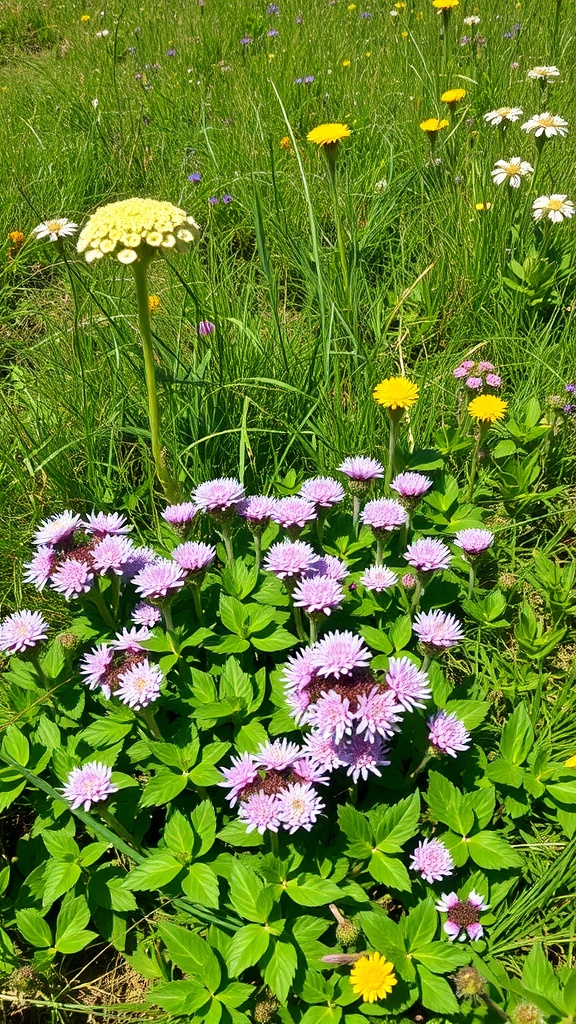
Purple flowering clover is a delightful sight in any meadow or garden. The vibrant purple blooms stand out beautifully against the lush green leaves. These flowers not only add color but also attract pollinators like bees and butterflies, making them a great choice for those looking to support local wildlife.
In the image, you can see clusters of purple clover flowers, surrounded by other wildflowers and grasses. This mix creates a lively and natural scene. The clover’s round blooms are soft and inviting, perfect for adding a touch of charm to your outdoor space.
There are several varieties of purple flowering clover, each with unique characteristics. Some are low-growing and spread quickly, while others may stand taller and provide more structure. These plants are hardy and can thrive in various conditions, making them a favorite among gardeners.
Whether you want to fill a garden bed or create a wildflower area, purple clover is a fantastic option. Its beauty and benefits make it a wonderful addition to any landscape.
Butterfly Bush with Purple Blooms
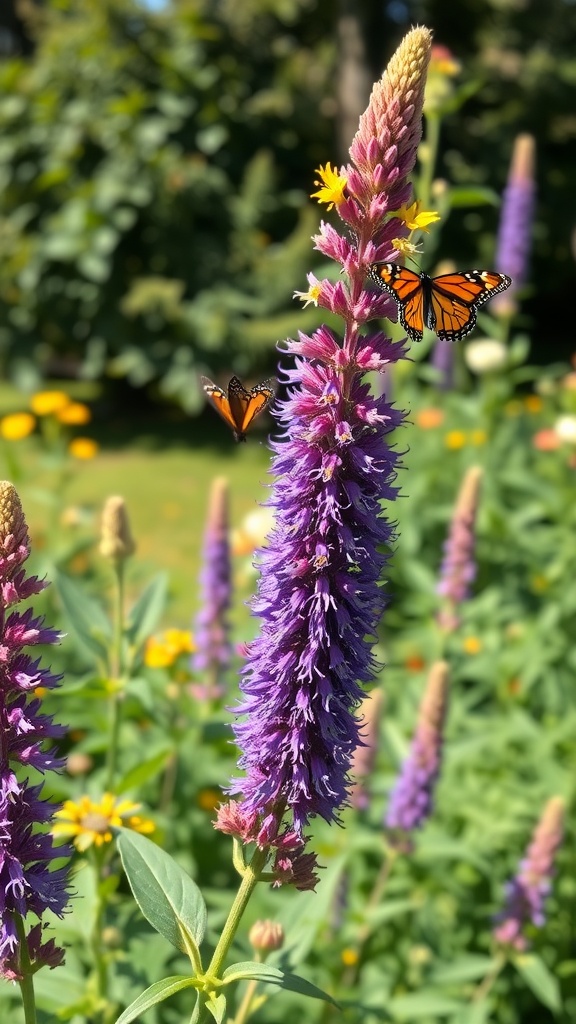
The Butterfly Bush is a stunning plant that brings a splash of color to any garden. Its tall spikes of purple flowers are not just beautiful; they attract butterflies, making your outdoor space lively and vibrant.
In the image, you can see these purple blooms standing tall, surrounded by lush green foliage. The flowers are rich in color, creating a striking contrast against the greenery. Butterflies, like the ones fluttering around, are drawn to these blooms, adding a touch of magic to the scene.
These plants are easy to care for and thrive in sunny spots. They can grow quite large, making them perfect for filling up garden spaces. If you want to attract more butterflies, planting a Butterfly Bush is a great choice!
Purple Flowering Buckthorn
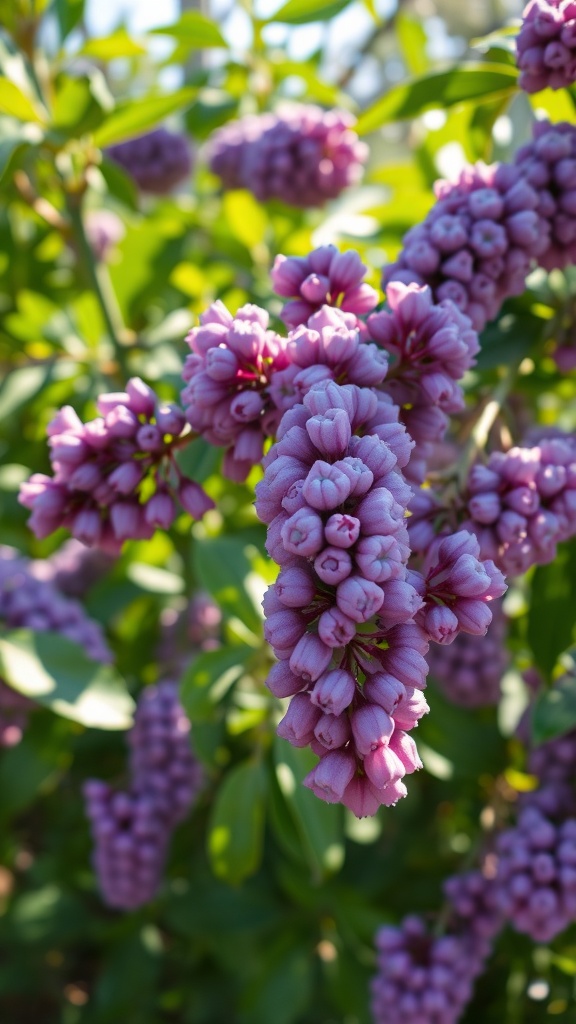
Purple flowering buckthorn is a striking plant that catches the eye with its beautiful clusters of purple blooms. These flowers are not just pretty; they add a pop of color to gardens and natural landscapes alike. The vibrant hues can range from soft lavender to deep violet, creating a stunning visual display.
This plant typically grows in clusters, making it a fantastic choice for adding volume to your garden. The flowers bloom in late spring to early summer, attracting pollinators like bees and butterflies. This makes it a great addition for anyone looking to support local wildlife.
While the purple flowering buckthorn is often admired for its beauty, it’s important to note that it can be invasive in some areas. Gardeners should keep an eye on its growth and manage it accordingly. With the right care, this plant can be a delightful feature in your garden, providing both beauty and ecological benefits.
Purple Flowering Dandelions
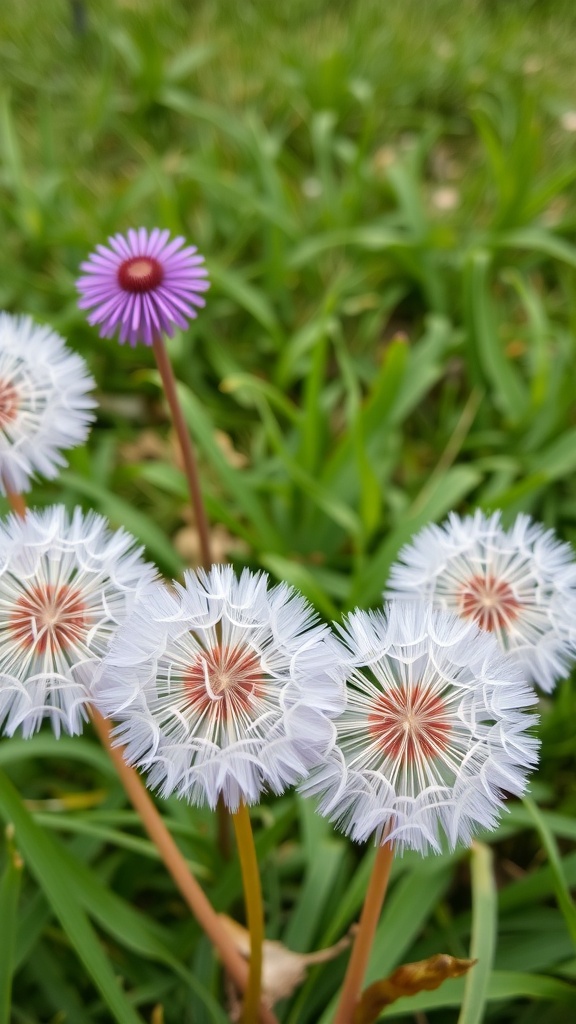
When you think of dandelions, you might picture the classic yellow blooms. However, some dandelions surprise us with their stunning purple flowers. These unique blooms add a pop of color to any garden or lawn.
In the image, you can see a group of dandelions with fluffy white seed heads, surrounded by vibrant green grass. Among them stands a striking purple flower, standing tall and proud. This purple flowering dandelion is not just beautiful; it also attracts pollinators like bees and butterflies.
These purple flowers are often mistaken for other species, but they belong to the same family as the common dandelion. They thrive in various environments and can be found in gardens, parks, and even along roadsides. Their resilience and beauty make them a favorite among wildflower enthusiasts.
Next time you spot a dandelion with purple flowers, take a moment to appreciate its charm. These little wonders remind us that nature is full of surprises, even in the most familiar places.
Purple Flowering Yarrow
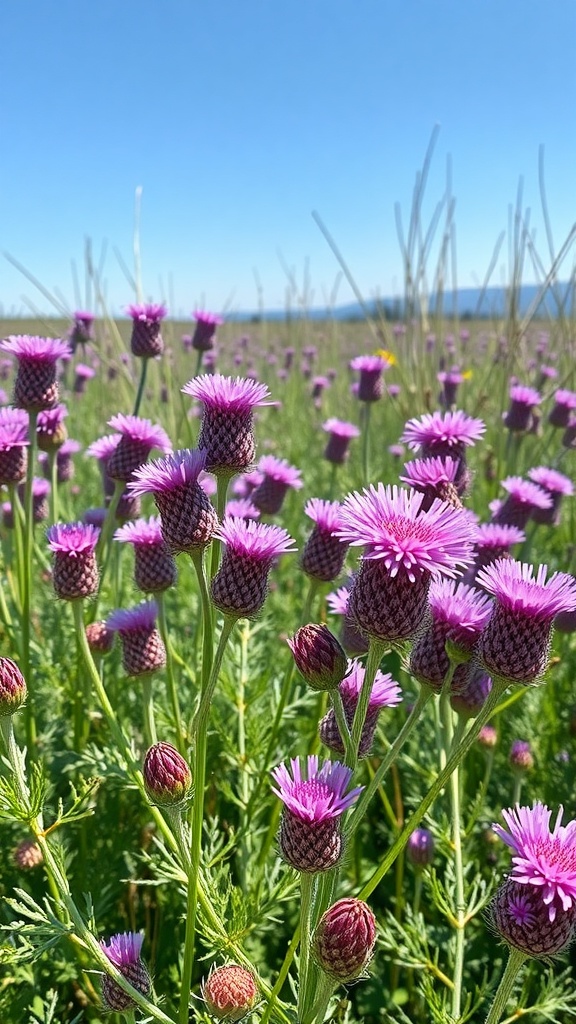
Purple flowering yarrow is a stunning sight in any field. The vibrant purple blooms stand tall, creating a beautiful contrast against the green foliage. These flowers can often be found in wildflower patches, adding a splash of color to the landscape.
The yarrow plant is known for its resilience and ability to thrive in various conditions. It grows in clusters, with each flower head resembling a tiny pom-pom. This unique shape makes it easy to spot from a distance.
Not only is yarrow visually appealing, but it also attracts pollinators like bees and butterflies. This makes it a great addition to gardens aimed at supporting local wildlife. Plus, yarrow has a rich history in herbal medicine, often used for its healing properties.
When you see a field of purple flowering yarrow, take a moment to appreciate its beauty. It’s a reminder of nature’s artistry and the simple joys found in wild spaces.
Wildflower Mix with Purple Blooms
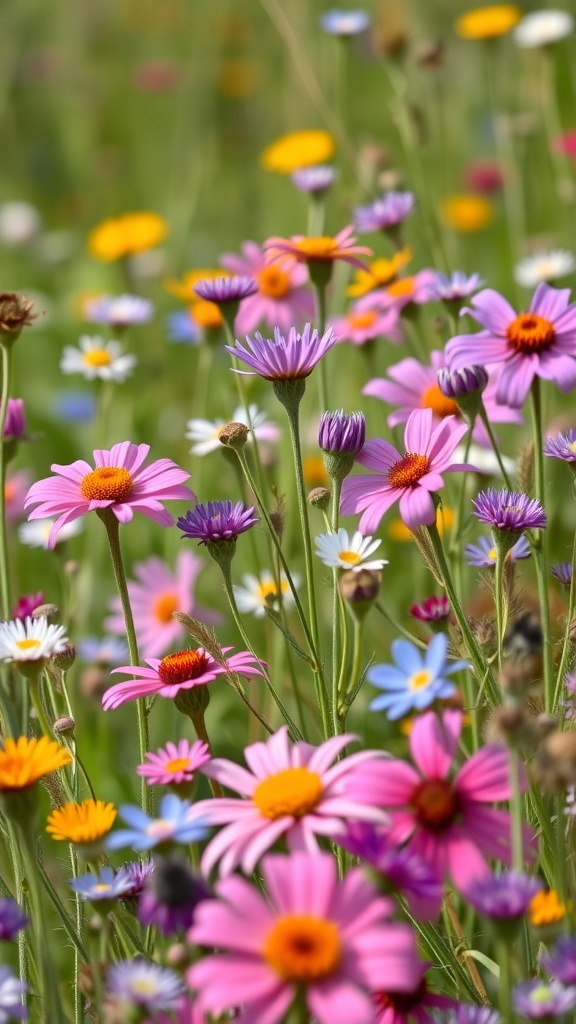
When you think of wildflowers, a burst of colors often comes to mind. Among these, purple blooms stand out beautifully. They add a touch of elegance to any wildflower mix. In this vibrant scene, you can see a delightful array of purple flowers mingling with pinks, yellows, and whites.
These purple flowers not only catch the eye but also attract pollinators like bees and butterflies. This mix creates a lively atmosphere in gardens and fields alike. The combination of colors makes it a perfect spot for a leisurely stroll or a picnic.
Planting a wildflower mix with purple blooms can be a great way to enhance your garden. It brings life and color, making it a joy to watch as the flowers sway in the breeze. Plus, it’s a low-maintenance option that supports local wildlife.
Lobelia Flowering in Gardens

Lobelia flowers are a delightful addition to any garden. Their vibrant purple hues stand out beautifully among other blooms. These flowers can create a stunning focal point, drawing the eye and adding charm to your outdoor space.
In the image, you can see lobelia flowers surrounded by a mix of colorful blooms. The rich purple petals contrast nicely with the reds, pinks, and whites of nearby flowers. This combination creates a lively and inviting atmosphere in the garden.
Lobelia thrives in both sunny and partially shaded areas, making it a versatile choice for various garden layouts. They are also known for attracting butterflies, which adds to the garden’s lively feel.
When planting lobelia, ensure they have well-drained soil and regular watering. With proper care, these flowers will bloom throughout the season, providing continuous color and joy.
Purple Flowering Groundsel Characteristics
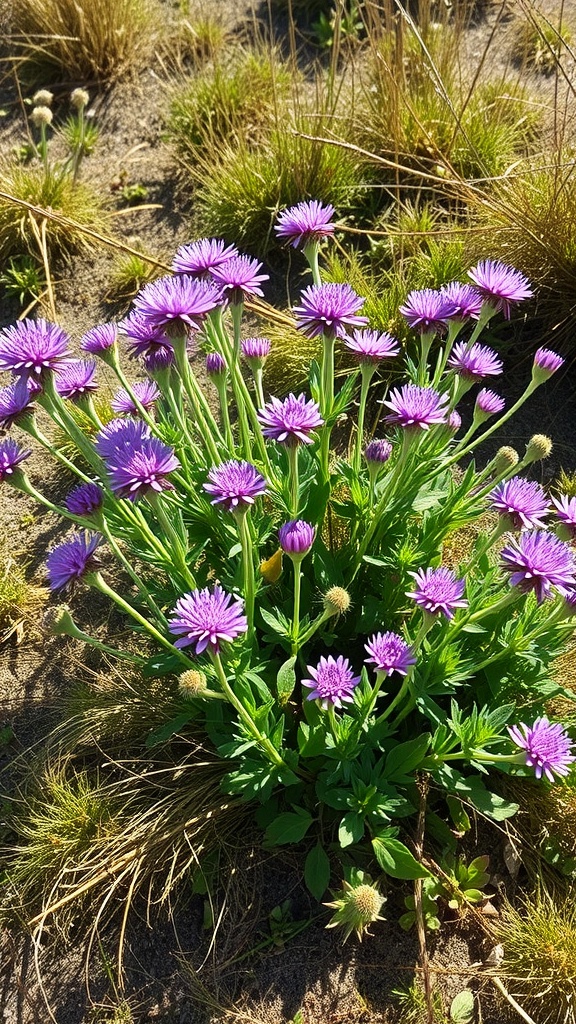
Purple flowering groundsel is a delightful sight in many gardens and wild areas. Its vibrant purple flowers stand out against the green foliage, creating a cheerful display. These flowers bloom in clusters, making them look like a burst of color on the landscape.
The leaves of the groundsel are typically broad and can vary in shape. They grow close to the ground, forming a lush base for the flowers. This plant is often found in sandy or disturbed areas, thriving in conditions where other plants may struggle.
One interesting feature of purple flowering groundsel is its ability to attract pollinators. Bees and butterflies are often seen visiting these flowers, drawn in by their bright color and nectar. This makes them a great addition to any garden looking to support local wildlife.
Overall, purple flowering groundsel is not just a pretty face. It plays a role in the ecosystem by providing food for pollinators and adding beauty to the environment. Whether you spot it in a garden or a wild patch, it’s hard not to appreciate its charm.
Cattails with Purple Flowering
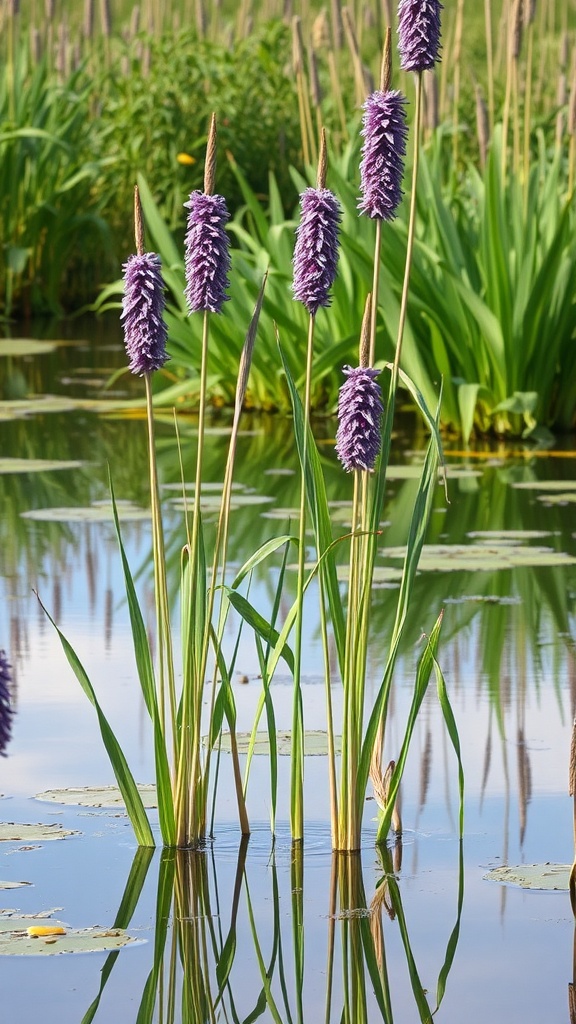
Cattails are fascinating plants that often grace wetlands and ponds. Their tall, slender stalks rise above the water, creating a striking silhouette. What makes them even more captivating are the purple flowers that bloom along these stalks. These vibrant blooms add a splash of color to the green landscape, making them a favorite among nature lovers.
The purple flowering on cattails is not just visually appealing; it also attracts various pollinators. Bees and butterflies are often seen fluttering around these flowers, drawn in by their bright hue. This interaction supports local ecosystems, showcasing how beauty and function go hand in hand in nature.
When you spot cattails with purple flowers, take a moment to appreciate their unique charm. They stand tall and proud, reflecting beautifully in the water below. This creates a serene scene that many enjoy capturing in photographs. Whether you’re walking by a pond or exploring a nature reserve, these plants are a delightful sight.
Purple Flowering Bindweed
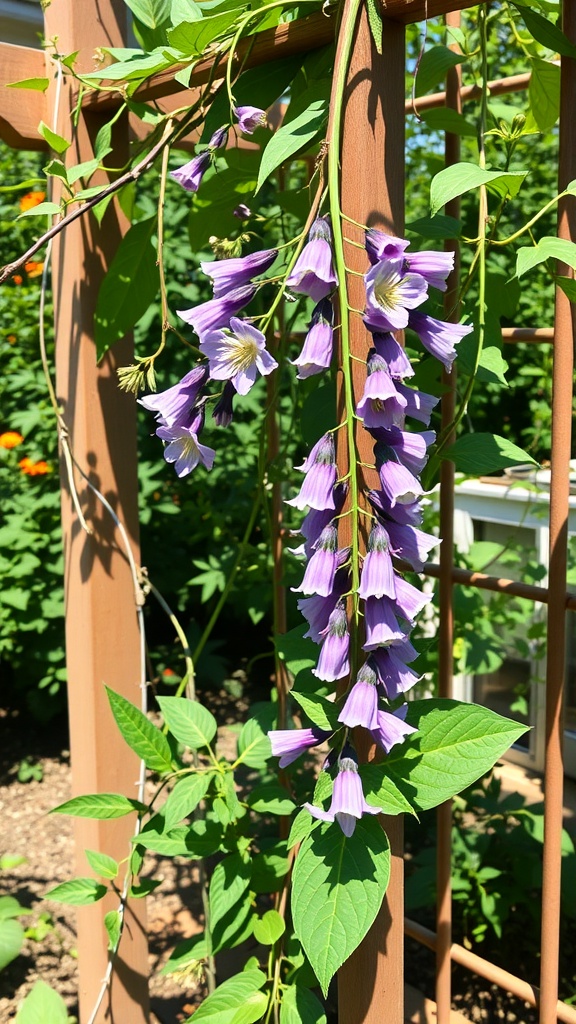
Purple flowering bindweed is a striking plant that often catches the eye with its vibrant purple blooms. These flowers have a unique shape, resembling small trumpets, and they hang gracefully from climbing vines. The contrast between the purple petals and the green leaves creates a beautiful display, making it a popular choice for gardens and trellises.
This plant is known for its ability to climb and spread quickly. It can often be found wrapping around fences or other structures, adding a splash of color to otherwise plain areas. While some may view it as a weed, its beauty cannot be denied.
In gardens, purple flowering bindweed can attract pollinators like bees and butterflies, making it a valuable addition to any outdoor space. Just be mindful of its growth habits, as it can become invasive if not managed properly.
